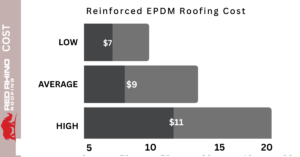
Thinking about upgrading your roof with a durable, weather-resistant material? Reinforced EPDM might be the solution—but at what cost?
When it comes to residential roofing materials, choosing the right option is crucial for long-term performance and cost-effectiveness. Reinforced EPDM (Ethylene Propylene Diene Monomer) roofing has gained popularity due to its enhanced durability and resistance to harsh weather conditions.
However, is the cost of reinforced EPDM roofing truly worth it? This blog will break down its costs, benefits, drawbacks, and comparisons with other materials to help you make an informed decision.
Cost breakdown of Reinforced EPDM Roofing
| Cost Type | Price (USD per sq. ft.) |
| Lowest Cost | $7.00 |
| Highest Cost | $11.00 |
| Average Cost | $9.00 |

Is reinforced EPDM the roofing upgrade your property needs? Let’s break down the costs!
| Type | Cost (USD per sq. ft.) |
| Polyester-Reinforced EPDM | $6 – $12 |
| Fiberglass-Reinforced EPDM | $5 – $10 |
| Fabric-Backed EPDM | $7 – $14 |
Introduction
Roofing choices can be overwhelming, especially when balancing durability with cost. Reinforced EPDM roofing cost varies based on factors like installation, material thickness, and labor. If you’re wondering, how much reinforced EPDM roofing costs?, it’s essential to compare the cost of reinforced EPDM membranes with alternatives. This guide covers the reinforced EPDM roof price per square foot, EPDM roofing installation cost, and the difference between reinforced EPDM vs standard EPDM cost to help you make an informed decision.
What is Reinforced EPDM Roofing?
Reinforced EPDM roofing is a variation of traditional EPDM, featuring an internal scrim layer made from polyester or fiberglass. This reinforcement enhances its strength, making it more resistant to punctures, tears, and extreme weather conditions.
Unlike standard EPDM, reinforced EPDM is commonly used in commercial roofing applications, but homeowners with large or high-traffic roofs may also benefit from it.
Types of Reinforced EPDM Roofing
Reinforced EPDM roofing comes in different types, each offering unique benefits based on structural needs, weather resistance, and longevity. Here are the most common types:
Polyester-Reinforced EPDM
| Type | Cost (USD per sq. ft.) |
| Polyester-Reinforced EPDM | $6 – $12 |
This type includes a polyester fabric layer for added tensile strength, making it ideal for high-traffic areas and commercial roofs.
Fiberglass-Reinforced EPDM
| Type | Cost (USD per sq. ft.) |
| Fiberglass-Reinforced EPDM | $5 – $10 |
A fiberglass mesh is integrated into the membrane to improve stability and minimize shrinkage over time.
Fabric-Backed EPDM
| Type | Cost (USD per sq. ft.) |
| Fabric-Backed EPDM | $7 – $14 |
Designed for superior adhesion, this option is perfect for fully adhered roofing systems and provides enhanced puncture resistance.
Differences Between Standard and Reinforced EPDM
- Standard EPDM: A flexible rubber roofing membrane without reinforcement, ideal for flat and low-slope roofs.
- Reinforced EPDM: Contains an embedded scrim layer, providing superior durability, better dimensional stability, and increased resistance to tears and punctures.
Factors Affecting the Cost of Reinforced EPDM Roofing
Roof Size and Complexity – Larger and more intricate roofs increase material and labor costs.
Labor Costs – Regional labor rates and contractor expertise impact total expenses.
Climate and Environmental Considerations – Areas with extreme weather may require additional installation reinforcements, increasing costs.
Advantages of Reinforced EPDM Roofing
Durability and Longevity
Reinforced EPDM roofing has a lifespan of 30-50 years, outperforming many other flat roofing materials. Its reinforced structure prevents shrinkage and reduces the risk of membrane failure.
Weather and UV Resistance
EPDM is naturally resistant to UV radiation, ozone, and extreme temperature fluctuations, making it ideal for various climates.
Energy Efficiency and Cost Savings
- Reflective coatings can be applied to reinforced EPDM to improve energy efficiency.
- Reduces cooling costs in hot climates by reflecting heat away from the building.
- Minimizes heating expenses in colder regions by providing insulation.
Potential Drawbacks of Reinforced EPDM Roofing
Initial Investment Costs
Reinforced EPDM is more expensive than traditional EPDM, requiring a higher upfront investment.
Installation Challenges
- Requires professional installation to ensure proper adhesion and performance.
- Seams need careful sealing to prevent leaks.
Compatibility with Certain Roof Structures
- Not suitable for steep-slope roofs.
- May require additional support in areas with heavy snow loads.
Comparing Reinforced EPDM Roofing with Other Roofing Materials
Standard EPDM vs. Reinforced EPDM
- Cost: Standard EPDM is cheaper but less durable.
- Durability: Reinforced EPDM is more resistant to tears and punctures.
- Best Use: Reinforced EPDM is ideal for high-traffic commercial roofs.
TPO vs. Reinforced EPDM
- TPO is more energy-efficient due to its reflective white surface.
- Reinforced EPDM is more flexible and has better resistance to UV radiation.
- Cost: TPO is slightly more expensive but offers better energy savings.
PVC vs. Reinforced EPDM
- PVC has superior chemical resistance and better seam strength.
- Reinforced EPDM is more cost-effective and flexible.
- Best Use: PVC is ideal for roofs exposed to harsh chemicals.
Is Reinforced EPDM Roofing Cost-Effective in the Long Run?
ROI (Return on Investment) Analysis
- Higher upfront cost but lower long-term maintenance expenses.
- Longer lifespan compared to standard EPDM and TPO.
- Fewer repairs due to enhanced durability.
Lifespan vs. Cost Considerations
While reinforced EPDM costs more initially, its extended lifespan and reduced repair costs make it a cost-effective investment over time.
Case Studies and Real-World Examples
Studies show that reinforced EPDM roofs in commercial buildings last 40+ years, outperforming many other roofing materials in durability and cost-effectiveness.
Cost Breakdown of Reinforced EPDM Roofing
The cost of reinforced EPDM varies depending on thickness and quality. On average:
Installation Costs
Professional installation typically costs between $5.00 – $12.00 per square foot, depending on roof complexity and labor rates in your area.
Material Costs
| Reinforced EPDM Thickness | Cost per Square Foot |
| 45-mil Reinforced EPDM | $1.50 – $3.00 |
| 60-mil Reinforced EPDM | $2.50 – $4.50 |
| 90-mil Reinforced EPDM | $4.00 – $6.00 |
More expensive than standard EPDM—but does reinforcing EPDM give you more?
Reinforced EPDM Roofing cost vs other types of EPDM roofing costs
| EPDM Roofing System | Estimated Cost per Square Foot |
| Fully Adhered to EPDM roof cost | $6.00 – $12.00 |
| Mechanically Attached EPDM roof cost | $5.25 – $10.50 |
| Ballasted EPDM roof cost | $4.50 – $9.00 |
| Reinforced EPDM roof cost | $7.80 – $11.70 |
| Non-Reinforced EPDM roof cost | $5.85 – $9.10 |
| Self-Adhered EPDM roof cost | $6.00 – $12.00 |
| Liquid-Applied EPDM roof cost | $4.20 – $14.25 |
| EPDM with White Reflective Coating roof cost | $4.00 – $5.00 |
| Tapered EPDM Roofing System Cost | $400-$600 |
To sum it up
Reinforced EPDM roofing is a premium solution that offers superior durability, weather resistance, and energy efficiency. While its initial cost is higher than standard EPDM and other flat roofing materials, the long-term savings in maintenance and repairs make it a cost-effective investment. With a lifespan of 30-50 years, reinforced EPDM provides excellent value for property owners looking for a reliable and long-lasting roofing system.
If you’re considering reinforced EPDM for your roofing project, consulting with an expert can help you make the best choice for your specific needs. Get professional guidance and a customized quote by visiting.
Frequently Asked Questions
It ranges from $7.80 – $11.70 per square foot, including materials and installation.
It has an internal scrim layer for extra strength, making it more durable and resistant to damage.
Yes, it’s ideal for large or high-traffic residential roofs due to its enhanced durability.
It’s more flexible and cost-effective, while TPO is better for energy efficiency and PVC excels in chemical resistance.
Professional installation is recommended for proper adhesion, seam sealing, and longevity.


